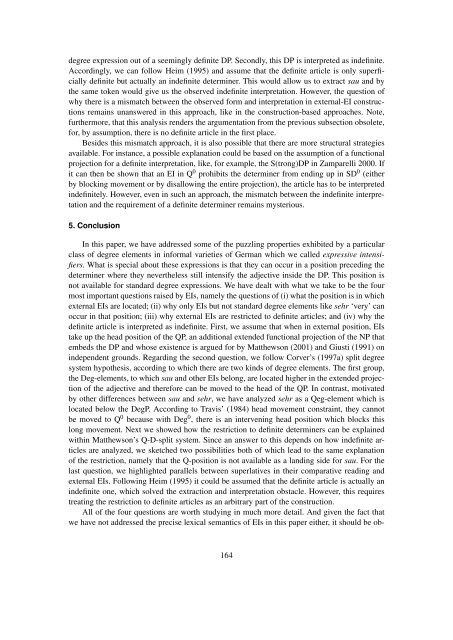Empirical Issues in Syntax and Semantics 9 (EISS 9 ... - CSSP - CNRS
Empirical Issues in Syntax and Semantics 9 (EISS 9 ... - CSSP - CNRS
Empirical Issues in Syntax and Semantics 9 (EISS 9 ... - CSSP - CNRS
Create successful ePaper yourself
Turn your PDF publications into a flip-book with our unique Google optimized e-Paper software.
degree expression out of a seem<strong>in</strong>gly def<strong>in</strong>ite DP. Secondly, this DP is <strong>in</strong>terpreted as <strong>in</strong>def<strong>in</strong>ite.<br />
Accord<strong>in</strong>gly, we can follow Heim (1995) <strong>and</strong> assume that the def<strong>in</strong>ite article is only superficially<br />
def<strong>in</strong>ite but actually an <strong>in</strong>def<strong>in</strong>ite determ<strong>in</strong>er. This would allow us to extract sau <strong>and</strong> by<br />
the same token would give us the observed <strong>in</strong>def<strong>in</strong>ite <strong>in</strong>terpretation. However, the question of<br />
why there is a mismatch between the observed form <strong>and</strong> <strong>in</strong>terpretation <strong>in</strong> external-EI constructions<br />
rema<strong>in</strong>s unanswered <strong>in</strong> this approach, like <strong>in</strong> the construction-based approaches. Note,<br />
furthermore, that this analysis renders the argumentation from the previous subsection obsolete,<br />
for, by assumption, there is no def<strong>in</strong>ite article <strong>in</strong> the first place.<br />
Besides this mismatch approach, it is also possible that there are more structural strategies<br />
available. For <strong>in</strong>stance, a possible explanation could be based on the assumption of a functional<br />
projection for a def<strong>in</strong>ite <strong>in</strong>terpretation, like, for example, the S(trong)DP <strong>in</strong> Zamparelli 2000. If<br />
it can then be shown that an EI <strong>in</strong> Q 0 prohibits the determ<strong>in</strong>er from end<strong>in</strong>g up <strong>in</strong> SD 0 (either<br />
by block<strong>in</strong>g movement or by disallow<strong>in</strong>g the entire projection), the article has to be <strong>in</strong>terpreted<br />
<strong>in</strong>def<strong>in</strong>itely. However, even <strong>in</strong> such an approach, the mismatch between the <strong>in</strong>def<strong>in</strong>ite <strong>in</strong>terpretation<br />
<strong>and</strong> the requirement of a def<strong>in</strong>ite determ<strong>in</strong>er rema<strong>in</strong>s mysterious.<br />
5. Conclusion<br />
In this paper, we have addressed some of the puzzl<strong>in</strong>g properties exhibited by a particular<br />
class of degree elements <strong>in</strong> <strong>in</strong>formal varieties of German which we called expressive <strong>in</strong>tensifiers.<br />
What is special about these expressions is that they can occur <strong>in</strong> a position preced<strong>in</strong>g the<br />
determ<strong>in</strong>er where they nevertheless still <strong>in</strong>tensify the adjective <strong>in</strong>side the DP. This position is<br />
not available for st<strong>and</strong>ard degree expressions. We have dealt with what we take to be the four<br />
most important questions raised by EIs, namely the questions of (i) what the position is <strong>in</strong> which<br />
external EIs are located; (ii) why only EIs but not st<strong>and</strong>ard degree elements like sehr ‘very’ can<br />
occur <strong>in</strong> that position; (iii) why external EIs are restricted to def<strong>in</strong>ite articles; <strong>and</strong> (iv) why the<br />
def<strong>in</strong>ite article is <strong>in</strong>terpreted as <strong>in</strong>def<strong>in</strong>ite. First, we assume that when <strong>in</strong> external position, EIs<br />
take up the head position of the QP, an additional extended functional projection of the NP that<br />
embeds the DP <strong>and</strong> whose existence is argued for by Matthewson (2001) <strong>and</strong> Giusti (1991) on<br />
<strong>in</strong>dependent grounds. Regard<strong>in</strong>g the second question, we follow Corver’s (1997a) split degree<br />
system hypothesis, accord<strong>in</strong>g to which there are two k<strong>in</strong>ds of degree elements. The first group,<br />
the Deg-elements, to which sau <strong>and</strong> other EIs belong, are located higher <strong>in</strong> the extended projection<br />
of the adjective <strong>and</strong> therefore can be moved to the head of the QP. In contrast, motivated<br />
by other differences between sau <strong>and</strong> sehr, we have analyzed sehr as a Qeg-element which is<br />
located below the DegP. Accord<strong>in</strong>g to Travis’ (1984) head movement constra<strong>in</strong>t, they cannot<br />
be moved to Q 0 because with Deg 0 , there is an <strong>in</strong>terven<strong>in</strong>g head position which blocks this<br />
long movement. Next we showed how the restriction to def<strong>in</strong>ite determ<strong>in</strong>ers can be expla<strong>in</strong>ed<br />
with<strong>in</strong> Matthewson’s Q-D-split system. S<strong>in</strong>ce an answer to this depends on how <strong>in</strong>def<strong>in</strong>ite articles<br />
are analyzed, we sketched two possibilities both of which lead to the same explanation<br />
of the restriction, namely that the Q-position is not available as a l<strong>and</strong><strong>in</strong>g side for sau. For the<br />
last question, we highlighted parallels between superlatives <strong>in</strong> their comparative read<strong>in</strong>g <strong>and</strong><br />
external EIs. Follow<strong>in</strong>g Heim (1995) it could be assumed that the def<strong>in</strong>ite article is actually an<br />
<strong>in</strong>def<strong>in</strong>ite one, which solved the extraction <strong>and</strong> <strong>in</strong>terpretation obstacle. However, this requires<br />
treat<strong>in</strong>g the restriction to def<strong>in</strong>ite articles as an arbitrary part of the construction.<br />
All of the four questions are worth study<strong>in</strong>g <strong>in</strong> much more detail. And given the fact that<br />
we have not addressed the precise lexical semantics of EIs <strong>in</strong> this paper either, it should be ob-<br />
164











